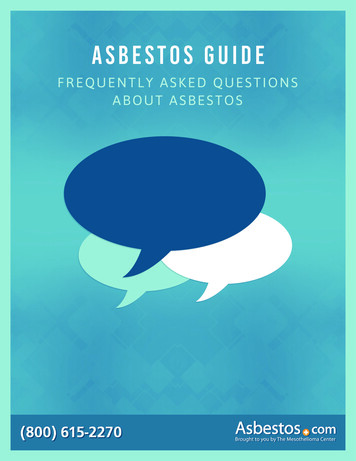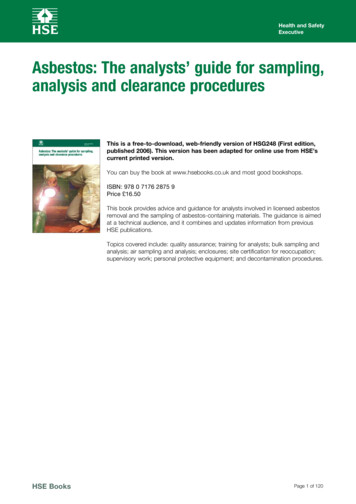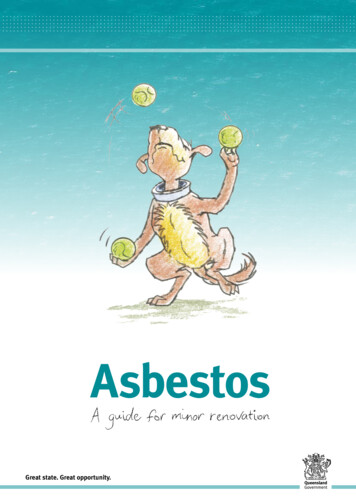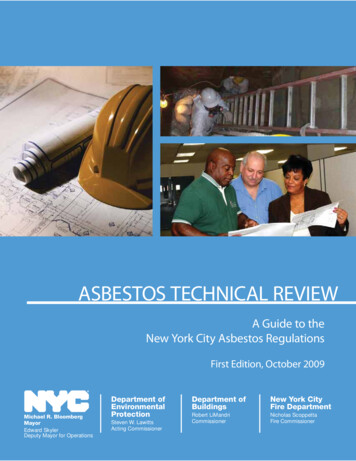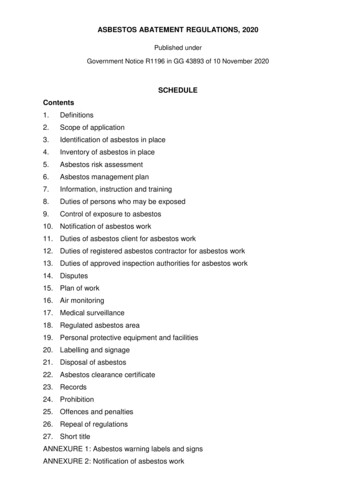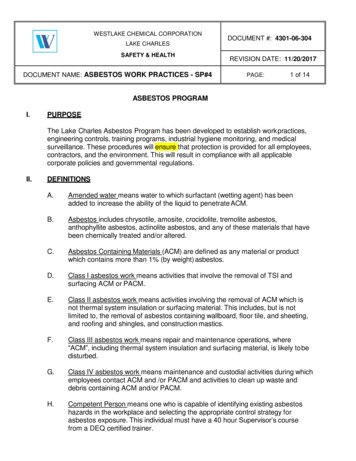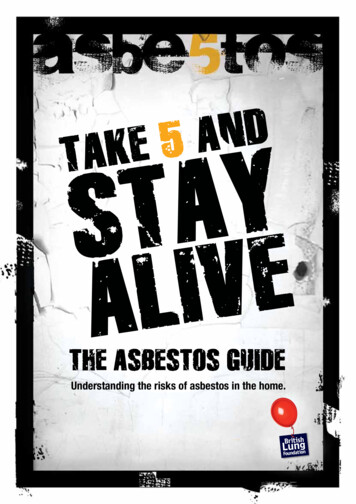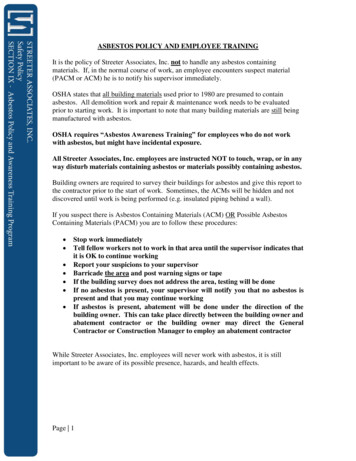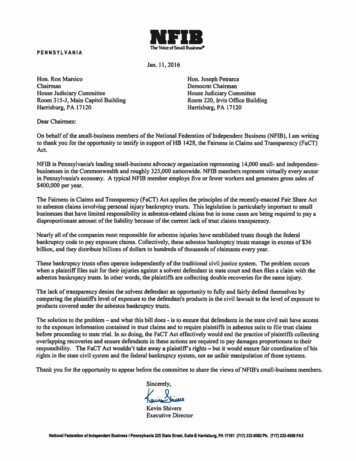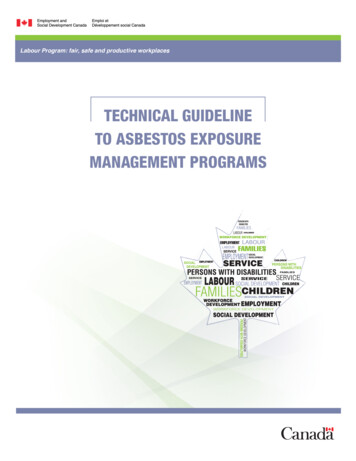
Transcription
Labour Program: fair, safe and productive workplacesTECHNICAL GUIDELINETO ASBESTOS EXPOSUREMANAGEMENT PROGRAMS
Technical Guideline to Asbestos Exposure Management ProgramsThis publication is available for download atcanada.ca/publicentre-ESDC.It is also available upon request in multiple formats (large print, Braille,audio CD, e-text CD, or DAISY), by contacting 1 800 O-Canada (1-800-622-6232).By teletypewriter (TTY), call 1-800-926-9105. Her Majesty the Queen in Right of Canada, 2018For information regarding reproduction FCat. No.: Em8-41/2018E-PDFISBN: 978-0-660-24459-4ESDCCat. No.: LT-300-02-18E
TECHNICAL GUIDELINETO ASBESTOS EXPOSUREMANAGEMENT PROGRAMSPrepared byMatthew Ziembicki, MPHIndustrial Hygiene TechnologistESDC – Labour ProgramEva A. Karpinski, M.Sc., P.Eng.Industrial Hygiene EngineerESDC – Labour ProgramJanuary 16, 2018This Guideline is intended to help health and safety professionals, employers, and employeesto evaluate exposures to airborne asbestos in workplaces governed by federal jurisdiction and toapply control measures. This Guideline advises on asbestos asessment and management strategiespertaining to asbestos and asbestos containing materials. The purpose of this Guideline is to supportthe Labour Program’s mandate of fostering safe and healthy workplace environments.
Table of Contents1. Introduction11.1 Issue11.2 Health effects of asbestos11.3 OHS Regulations definitions21.4 Additional definitions not included in OHS Regulations52. The first task that must be done before a work activityis conducted on suspected asbestos-containing material72.1 Examples of special cases73. Required steps in a hazard investigation84. Required steps in a risk assessment95. Asbestos sampling105.1 Monitoring105.2 Clearance air sampling116. Required control measures and protection equipmentfor low, moderate and high risk activities126.1 Ventilation126.2 Protection equipment136.3 Respiratory protection146.4 Monitoring156.5 Low risk activities156.6 Employer’s responsibilities before moderateor high risk activities commence156.7 Moderate risk activities166.8 High risk activities176.9 Other control measures197. Disposal of asbestos-containing material waste208. Creating an asbestos exposure control plan229. Required control measures for asbestos-containingfriction materials2310. References24
1. Introduction1.1 IssueIn the update to the five occupational health and safety regulations under the Canada Labour Code, Part I :1Canada Occupational Health and Safety Regulations (COHSR);2 On Board Trains Occupational Healthand Safety Regulations (OTOHSR);3 Oil and Gas Occupational Safety and Health Regulations (OGOSHR);4Maritime Occupational Health and Safety Regulations (MOHSR);5 and Aviation Occupational Healthand Safety Regulations (AOHSR),6 the occupational exposure limit (OEL) for chrysotile asbestos was reducedfrom 1 fibre per cubic centimetre (f/cc) to 0.1 f/cc and the requirement of an asbestos exposure managementprogram was added. The purpose of this technical guideline is to provide guidance on asbestos issues relatingto Part X of the COHSR, Hazardous Substances, and to relevant provisions in other Regulations pursuant tothe Canada Labour Code, Part II.1 This guideline is an expansion of selected sections of the regulation.1.2 Health effects of asbestosAll forms of asbestos, including chrysotile, have been shown through extensive scientific studies to becarcinogenic health hazards in humans. Asbestos is classified by the International Association for Researchon Cancer (IARC) as a Group 1 carcinogen, meaning carcinogenic to humans.7 Group 1 is the highest levelof strength of evidence for carcinogenicity in the IARC carcinogen classification system.8 Similarly, asbestosis classified by the American Conference of Governmental Industrial Hygienists (ACGIH ) as a Group A1carcinogen, meaning confirmed human carcinogen. Group A1 agents are carcinogenic to humans basedon the weight of evidence from epidemiologic studies.9Asbestos has been shown to cause lung cancer and mesothelioma twenty years or later from afirst asbestos exposure to disease development.7, 10 According to the Institute for Work and Healthpublication New cases of mesothelioma and asbestos-related lung cancer in one year cost 1.9B,in 2011 alone, 2,331 new Canadian cases of mesothelioma and lung cancer were attributed to occupationaland para‑occupational exposures to asbestos.11 During the period 2007–2011, there were, on average,approximately 13 asbestos-related occupational fatalities per year and 8 asbestos-related occupationalinjuries per year in the federal jurisdiction.10 More information on asbestos can be found in the Employmentand Social Development Canada (ESDC) Labour Program Asbestos Hazard Alert.12TECHNICAL GUIDELINE TO ASBESTOS EXPOSURE MANAGEMENT PROGRAMS1
1.3 OHS Regulations definitions2Airborne asbestos fibreAsbestos fibres that are longer than 5 µm (micrometres) with an aspectratio equal to or greater than 3:1 and that are carried by the air.AsbestosActinolite, amosite, anthophyllite, chrysotile, crocidolite and tremolitein their fibrous form.Asbestos-containingmaterial (ACM)Means:(a) Any article that is manufactured and contains 1% or moreasbestos by weight at the time of manufacture or that contains aconcentration of 1% or more asbestos as determined in accordancewith Method 9002 set out in the document entitled NIOSH Manualof Analytical Methods published by the National Institute forOccupational Safety and Health, as amended from time to time,or in accordance with a scientifically proven method used to collectand analyze a representative sample of the material; and(b) Any material that contains a concentration of 1% or moreasbestos as determined in accordance with Method 9002 setout in the document entitled NIOSH Manual of Analytical Methodspublished by the National Institute for Occupational Safety and Health,as amended from time to time, or in accordance with a scientificallyproven method used to collect and analyze a representative sampleof the material.Clearance air samplingSampling to determine if the concentration of airborne asbestos fibreinside an enclosure is below the limit referred to in COHSR section 10.19to permit the dismantling of a containment system.Clearance air samplinginterpretationThe use of aggressive air sampling techniques with a volume of aircollected to determine the concentration of residual airborne asbestosfibres within the asbestos containment. This type of air sampling occursat the very end of the asbestos abatement process.ContainmentAn isolation system that is designed to effectively contain asbestos fibrewithin a designated work area where asbestos-containing material ishandled, removed, encapsulated or enclosed, and includes a glove bag.EncapsulationTreatment of an asbestos-containing material with a sealant that penetratesthe material and binds the asbestos fibres together, and treatment of thesurface of the asbestos-containing material with a sealant that createsa membrane on the surface, to prevent the release of asbestos fibresinto the air.EnclosureA physical barrier such as drywall, plywood, metal sheeting or glove bag,as part of a containment system, that isolates asbestos-containing materialfrom adjacent areas in a building to prevent the release of airborneasbestos into those areas.TECHNICAL GUIDELINE TO ASBESTOS EXPOSURE MANAGEMENT PROGRAMS2
Enclosure interpretationThe list of appropriate physical barrier types is not a complete list andother materials may be used for an enclosure, such as polyethylene.However, any polyethylene used for an asbestos enclosure must be atleast one layer of polyethylene that is 0.15 mm (6 mil) thick or greater.FriableMeans, in respect of asbestos-containing material, that the material,when dry, can be easily crumbled or powdered by hand pressure.Glove bagA polyethylene or polyvinyl chloride bag affixed around anasbestos‑containing source that permits the material to be removedwhile minimizing release of airborne asbestos into the workplace.HEPA filterA high-efficiency particulate air filter that has been tested to ensureefficiency equal to or exceeding 99.97% for removal of airborne particleshaving a mean aerodynamic diameter of 0.3 µm (micrometres)from the air.High-risk activityMeans activity that involves the handling or the disturbance offriable asbestos-containing material or working in proximity to friableasbestos-containing material, where there is a high level of controlnecessary to prevent exposure to excessive concentrations of airborneasbestos and includes:(a) the removal or disturbance of more than 1 m2 of friableasbestos‑containing material in a workplace even if the activityis divided into smaller jobs;(b) the spray application of a sealant to friableasbestos‑containing material;(c) cleaning or removing air-handling equipment, but not includingfilters, in a building that has sprayed-on fireproofing thatis asbestos-containing material;(d) repairing, altering or demolishing any part of a kiln, metallurgicalfurnace or similar structure that contains asbestos-containingmaterials;(e) breaking, cutting, drilling, abrading, grinding, sanding or vibratingnon-friable asbestos-containing material, if the activity is doneby means of power tools that are not attached to dust-collectingdevices equipped with HEPA filters; and(f) repairing, altering or demolishing any part of a building inwhich asbestos is or was used in the manufacture of products,unless the asbestos was cleaned up and removed.TECHNICAL GUIDELINE TO ASBESTOS EXPOSURE MANAGEMENT PROGRAMS3
Low-risk activityMeans activity that involves the handling of asbestos-containingmaterial or working in proximity to non-friable asbestos-containingmaterial and includes:(a) installing or removing ceiling tiles that are non-friableasbestos‑containing material and cover an area less than 7.5 m2;(b) installing or removing other non-friable asbestos-containingmaterials if the material is not being broken, cut, drilled, abraded,ground, sanded or vibrated, and dust is not being generated;(c) breaking, cutting, drilling, abrading, grinding, sanding or vibratingnon-friable asbestos-containing material if the material is wettedto control the spread of dust or fibres, and the activity is doneonly with non-powered hand-held tools; and(d) removing less than 1 m² of drywall in which joint cementcontains asbestos.Moderate-risk activityMeans activity that involves the handling of asbestos-containingmaterial or working in proximity to friable asbestos-containing material,not otherwise classified as low-risk and high-risk activities and includes:(a) removing all or part of a false ceiling to obtain access to a work area,if asbestos-containing material is likely to be lying on the surfaceof the false ceiling;(b) the removal or disturbance of 1 m2 or less of friableasbestos‑containing material during the repair, alteration,maintenance or demolition in a workplace;(c) enclosing friable asbestos-containing material;(d) applying tape or a sealant or other covering to pipe or boilerinsulation that is asbestos-containing material;(e) removing ceiling tiles that are asbestos-containing material, if the tilescover an area greater than 2 m2 and are removed without beingbroken, cut, drilled, abraded, ground, sanded or vibrated;(f) breaking, cutting, drilling, abrading, grinding, sanding or vibratingnon-friable asbestos-containing material if:}} the material is not wetted to control the spread of dustor fibres; and}} the activity is done only by means of non-poweredhand‑held tools;(g) removing 1 m2 or more of drywall in which joint cementthat is asbestos-containing material has been used;(h) breaking, cutting, drilling, abrading, grinding, sanding or vibratingnon-friable asbestos-containing material if the activity is done bymeans of power tools that are attached to dust-collecting devicesequipped with HEPA filters;TECHNICAL GUIDELINE TO ASBESTOS EXPOSURE MANAGEMENT PROGRAMS4
(i) removing insulation that is asbestos-containing materialfrom a pipe, duct or similar structure using a glove bag; and(j) cleaning or removing filters used in air-handling equipmentin a building that has sprayed fireproofing that isasbestos‑containing material.Qualified personIn respect of a specified duty, a person who, because of theirknowledge, training and experience, is qualified to performthat duty safely and properly.Qualified person interpretationThe specified duty with respect to asbestos is the asbestos hazardinvestigation, risk assessment and abatement process, includingrequired control measures to prevent employee exposure to asbestos.Work activityAny low risk activity, moderate risk activity or high risk activityor any activity that is ancillary to that activity, and the supervisionof that activity and that ancillary activity.1.4 Additional definitions not included in OHS Regulations10Aggressive air samplingA technique for air sampling in which the individual collecting theair sample creates air movement by the use of forced air equipmentduring the sampling period to stir up any settled dust and to simulateactivity in that area of the building.Asbestos abatementAny work conducted on ACM to safely remove, encapsulate, enclose,or repair the ACM to prevent the exposure of employees to airborneasbestos fibres.Bulk samplingRemoving a piece of suspected ACM for laboratory testing for thepresence of 1% or more asbestos content by weight in the material.This occurs during the hazard investigation. Representative samplesof all suspected ACM are taken for analysis.Regarding bulk sampling of vermiculite insulation and other materialsthat may have an uneven asbestos distribution, that are suspected ACMs,a qualified person is still responsible for conducting proper bulk samplingusing NIOSH Method 9002 or another equivalent scientifically provenmethod. Due to the analytical challenges that asbestos-contaminatedvermiculite poses, the qualified person must take a larger than normalbulk sample and/or more bulk samples than normal in order to obtaina more representative sample of any vermiculite insulation present inthe workplace than the bulk sampling procedure for materials that havean even distribution of asbestos. The qualified person using a modifiedbulk sampling procedure must still comply with the specifications of thechosen sampling and analysis method. The COHSR definition of ACMas 1% or more asbestos by weight still applies to vermiculite insulation.TECHNICAL GUIDELINE TO ASBESTOS EXPOSURE MANAGEMENT PROGRAMS5
Clean roomA room without asbestos contamination. Specifically, it is anuncontaminated change room where the clean street clothes ofasbestos abatement workers are stored. Air sampling is required toverify that this room has not been contaminated with asbestos fibres.ContaminationWith respect to asbestos; the presence of asbestos dust that contactsan object and would require proper cleaning or replacement to allowa person to use the object without causing asbestos exposure.Friction materialA material that has a high coefficient of friction and is used to makecomponents that operate under conditions of sliding friction. Specifically,these are components of manufactured automotive parts that includebrake pads, brake shoes, and dry friction clutches.Hazard investigationA preventative investigation of a possible occupational health or safetyhazard due to a hazardous substance according to COHSR 10.4. This isseparate from hazardous occurrence investigation and reporting (HOIR),which is a reactionary root-cause investigation of a workplace incident.Risk assessmentThis must be conducted by a qualified person before asbestos abatementwork begins. It is the determination if the proposed work activity is a low,moderate or high risk activity. A risk assessment is based on the typeand amount of asbestos present in the ACM and the extent of work onACM that needs to be done in order to prevent employees from beingexposed to airborne asbestos fibre.Zero airborne asbestosconcentrationThe concentration of “zero” airborne asbestos fibres inCOHSR 10.19 (1.1, 3) corresponds to a recognized asbestos analyticalmethod, such as NIOSH Method 7400 or NIOSH Method 7402, used toanalyze an asbestos sample that returns a result that is below the limit ofdetection (LOD) of the analytical method. The LOD of NIOSH Method 7400and of NIOSH Method 7402 is less than 0.01 f/cc. After a qualified personconducts asbestos air sampling, when a result is below the limit of detectionfor that method, the asbestos sample can be effectively considered to be“none detected” or “zero”. The specific value of the LOD is set by thetechnological limits of the analytical equipment required in the analyticalmethod, rather than being chosen by a person.TECHNICAL GUIDELINE TO ASBESTOS EXPOSURE MANAGEMENT PROGRAMS6
2. The first task that must be done beforea work activity is conducted on suspectedasbestos-containing materialThe first task for the employer to complete is to determine whether it is ACM, which is done through a hazardinvestigation. Once the hazard investigation, in accordance with COHSR section 10.4, has been conducted,the employer must readily provide the hazard investigation report to the workplace health and safety committeeand employees.2 If a hazard investigation has not been conducted on the suspected ACM, the employermust hire a qualified person to conduct a hazard investigation on the suspected ACM.The regulatory requirement for damaged asbestos that a hazard investigation aims to address is COHSRsection 10.26.2 (c-d):(c) ensure that all asbestos-containing material in the workplace that is exposed or thatwill be disturbed is identified by signs and labels or by any other effective manner;(d) ensure that all friable asbestos-containing material present in the workplace is controlledby removal, enclosure or encapsulation or by any other effective manner to preventexposure of employees to asbestos.The Canada Labour Code, Part II section 124: General Duty of Employer states that the employer isresponsible for employee health safety in the workplace.1 The employer is also required to collaboratewith employees on occupational health and safety through a workplace health and safety committee orhealth and safety representative. When an employer does not have full control or ownership over a workplace,the employer must take all reasonable precautions to ensure the health and safety of its employees.If it exists, the employer must readily provide the asbestos inventory and asbestos exposure control planof the building containing the workplace to employees who request it. The asbestos inventory and asbestosexposure control plan must be consulted to check for the documented presence of ACM and the type ofasbestos mineral present in the proposed work area. Other asbestos-related details in the building-specificdocuments should also be considered before asbestos work begins. If the asbestos inventory or asbestosexposure control plan states that asbestos is present in the area of the workplace in question or if the presenceof asbestos is unknown, a hazard investigation of that area must be conducted.2 The employer must alsotake proper preventive precautions by evacuating and isolating the area in question from the rest of theworkplace. Any work activity on ACM must be thoroughly documented and entered into the workplaceasbestos inventory.2.1 Examples of special casesA federally-regulated employer is a tenant in a provincially-regulated multi-tenant building,such as a shopping mall:The federally-regulated employer must comply with federal regulations that apply to theworkplace instead of provincial regulations. The workplace in a multi-tenant building is withinthe space that is leased or rented by the federally-regulated employer. The employer must alsoprovide employees safe entry to and exit from the leased space [CLC section 125 (1)(p)].TECHNICAL GUIDELINE TO ASBESTOS EXPOSURE MANAGEMENT PROGRAMS7
An employee or contractor of a federally-regulated employer, such as a telecommunications company,working with suspected ACM in the private home of a client:Sampling and analyzing suspected ACM from a private home in order for a telecommunicationscompany employee or contractor to conduct a moderate risk short duration installation, repair,or maintenance work activity that may generate dust may be unreasonable in some instances.Instead, the employer is required to follow the COHSR to provide employees with training torecognize situations of potential asbestos exposure hazards and training in the use of respiratoryprotective equipment (RPE) and personal protective equipment (PPE).Other procedures and equipment for a moderate or low risk activity must be used, such as a drop sheetand a HEPA vacuum cleaner or damp wipes for containing any dust generated to the immediate work areaand for cleaning the area after work is completed.Additionally, the employer must also provide the appropriate RPE, PPE, and other appropriate asbestosabatement equipment to employees.2 Thus, the employee may assume a material is an ACM in this situationand will have the proper equipment to prevent exposure to dust from a suspected ACM before starting anywork. Personal protective equipment includes a respirator, gloves and protective clothing. The employer shoulddocument and maintain records of employee use of RPE and PPE for suspected ACM in a private home toassist in complying with the identification of ACM requirement of COHSR 10.26.2(c). If it is not possible toidentify ACM by signs and labels, then any other effective manner may be used to fulfill this requirement.3. Required steps in a hazard investigationA hazard investigation of suspected ACM must be conducted prior to any work on the suspected ACM inaccordance with COHSR section 10.4. The hazard investigation must be conducted by a qualified person.Please refer to the ESDC Labour Program document Guide to the Management of Hazardous Substancesfor more details on hazard investigations.13 The purpose of a hazard investigation is to determine if thesuspected ACM contains asbestos. Representative bulk samples of suspected ACM must be taken by aqualified person following NIOSH Method 9002 or an equivalent sampling method.14 If the suspected ACMtested has a negative result for asbestos (contains less than 1% asbestos by weight), then no further asbestosprecautions are required for that tested construction material. If the suspected ACM has a positive result forasbestos (contains 1% or more asbestos by weight), then an asbestos risk assessment must be conductedbefore any invasive work is done in that area of the workplace.COHSR section 10.26.2 (d) states that the employer must:Ensure that all friable asbestos-containing material present in the workplace is controlledby removal, enclosure or encapsulation or by any other effective manner to prevent exposureof employees to asbestos.TECHNICAL GUIDELINE TO ASBESTOS EXPOSURE MANAGEMENT PROGRAMS8
The bolding of certain words of COHSR section 10.26.2 (d) above is for emphasis. Although the aboverequirement for employers seems very broad, it has some limits. The phrase “present in the workplace” can beinterpreted as accessible to employees performing their normal work. For example, friable ACM that is enclosedbehind a surface such as a wall or ceiling would be in compliance with COHSR section 10.26.2 (d) as long asemployees are not exposed to asbestos fibres, since it is already enclosed and not accessible to employeesperforming their normal work.Thus, sprayed-on asbestos-containing fire proofing in good condition located above a drop ceiling does notneed to be removed, further enclosed, or encapsulated. However, the employer must monitor the conditionof ACM and monitor for the release of asbestos fibres into the workplace air by air sampling for asbestosin the vicinity of the ACM by a qualified person (see section 5.2 for further details on air monitoring).As well, the phrase “any other effective manner” is inclusive of any method that effectively preventsthe exposure of employees to asbestos. This may include maintaining the ACM in good condition and wouldrequire frequent and regular visual inspections and air sampling in the vicinity of the ACM by a qualified personto monitor the ACM integrity. As well, the employer must ensure that the integrity of the ACM is maintainedby protecting it from physical damage and from other sources of damage, such as water damage. When theACM integrity is less than a good condition, as determined by a qualified person, then the employer mustuse another control method to prevent the exposure of employees to asbestos.4. Required steps in a risk assessmentA risk assessment must be conducted by a qualified person before asbestos abatement work begins.The purpose of a risk assessment is to determine if the proposed work on the ACM is a low, moderate orhigh risk activity. A risk assessment is based on the type and amount of asbestos present in the ACM and theextent of work on ACM that needs to be done in order to prevent employees from being exposed to airborneasbestos fibres.2Additionally, for low, moderate and high risk activities, as well as to asbestos-containing friction materials,the employer must comply with COHSR sections 10.8 and 10.9 which state:10.8 Every hazardous substance stored, handled or used in a workplace shall be stored,handled or used in a manner whereby the hazard related to that substance is reducedto a minimum.10.9 Where a hazardous substance is stored, handled or used in a workplace, any hazardresulting from that storage, handling or use shall be confined to as small an areaas is practicable.When specialized asbestos abatement contractors are hired by an employer to conduct an asbestos abatementproject, the contractor must develop and implement appropriate asbestos abatement procedures. The employermust ensure that the procedures and control measures of the contractor are in place. The employer mustalso conduct air sampling in the vicinity of the asbestos abatement especially if normal work or occupancywill continue in the building during the abatement. The employer must also instruct employees not to enteror disturb the asbestos abatement enclosure (COHSR 10.13, 10.26.2).TECHNICAL GUIDELINE TO ASBESTOS EXPOSURE MANAGEMENT PROGRAMS9
5. Asbestos sampling5.1 MonitoringCOHSR section 10.26.8 states that:(1) An employer shall ensure that a qualified person takes air samples to test for airborneasbestos fibres:(a) in the vicinity of the containment system during any work activity that involvesasbestos-containing material and, in the case of a work activity that lasts longerthan 24 hours, at least daily;(b) in the clean room during removal and clean-up operations and, in the case ofremoval and clean-up operations that last longer than 24 hours, at least daily; and(c) in contaminated areas that are inside the containment system as necessaryduring removal and clean-up operations.(2) The employer shall ensure that the following air samples are taken:(a) two samples for every area in an enclosure that is 10 m2 or less;(b) three samples for every area in an enclosure that is more than 10 m2and not more than 500 m2; and(c) five samples for every area in an enclosure that is more than 500 m2.(3) Within 24 hours after obtaining the air sampling test results, the employer shall:(a) post a copy of the results in a conspicuous place in the work place; and(b) make the results available to the policy committee, if any, the work placecommittee and the health and safety representative.For high risk and moderate risk activities that use an enclosure, a containment system, or a clean room,a qualified person must conduct daily air sampling of asbestos fibres in the prescribed work area for thefull shift of the asbestos abatement employees to monitor the concentration of airborne asbestos fibres.Please refer to the ESDC Labour Program guideline Canadian Occupational Chemical Agent ComplianceSampling Guideline for more details on proper air sampling.15 Furthermore, a qualified person should usesuitable air sampling equipment that can easily detect a concentration of airborne asbestos fibres of 0.1 f/cc.When a qualified person takes air samples for occupational exposure to asbestos, the sampling resultsmust be compared to the asbestos OEL of 0.1 f/cc or to a concentration of “zero” airborne asbestos fibres.The qualified person has responsibility for air sampling. They may use 50% of the 0.1 f/cc OEL as an actionlevel for additional control measures for daily asbestos air monitoring. Daily air sampling for airborne asbestosfibres is not required for low risk activities, including low risk activities that last longer than 24 hours if anenclosure, a containment system, or a clean room is not constructed or used. In a low risk activity, no airborneasbestos fibres can be generated, only non-friable ACM can be worked on, and an enclosure is not required.If airborne asbestos fibres are generated or friable ACM is encountered, then the risk activity level mustbe reclassified from low to moderate or high.2TECHNICAL GUIDELINE TO ASBESTOS EXPOSURE MANAGEMENT PROGRAMS10
In any case where there is a likelihood that asbestos fibres may be released, a qualified person maytake air samples [COHSR 10.19(3)]. Importantly, all analyses of asbestos samples must be conductedin a laboratory that is accredited for the relevant analysis methods.5.2 Clearance air samplingCOHSR 10.26.9 (1) states that:Before dismantling a containment and after all asbestos dust, waste and debris have beencleaned up, removed or encapsulated, an employer must ensure that clearance air samples aretaken inside the enclosure and the concentrations of airborne asbestos fibre are determined inaccordance with Method 7400 set out in the document entitled NIOSH Ma
asbestos-containing material during the repair, alteration, maintenance or demolition in a workplace; (c) enclosing friable asbestos-containing material; (d) applying tape or a sealant or other covering to pipe or boiler insulation that is asbestos-containing material; (e) removing ceiling tiles that are asbestos-containing material, if the tiles

